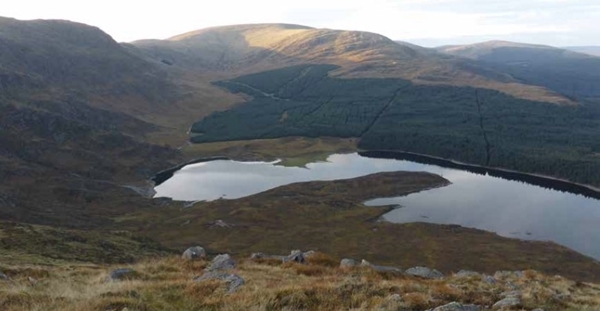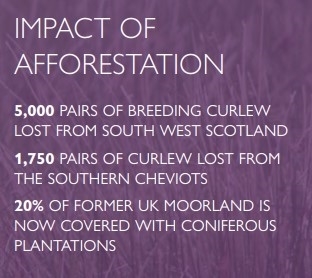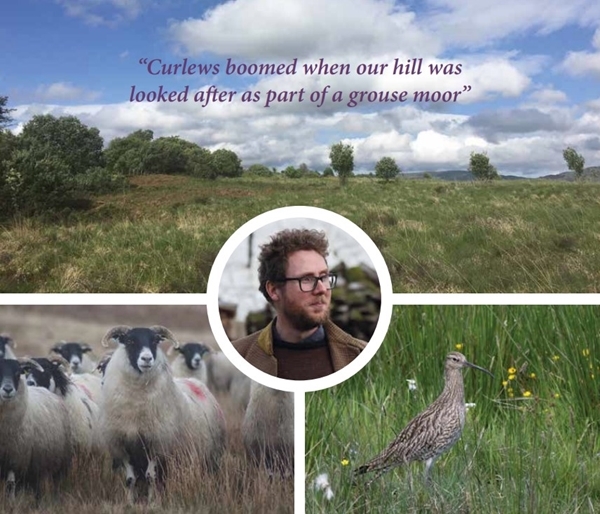
This case study is taken from our Real Wilders book, which you can download here or you can buy a print copy here.
The recent extinction of the curlew in southern Scotland is a warning of the threat to rare species posed by the current trend for woodland creation.
Over the last ten years, curlews have emerged as a leading priority for conservationists in the UK. Their numbers have declined by more than two thirds since the mid-1990s, and there are now real fears that the birds could become extinct as a breeding species, particularly in Wales and the south of England. This decline is even more concerning because the UK holds a large proportion of the world’s Eurasian curlew population, which is classified by the IUCN as ‘Near Threatened’.
Research has shown that curlews can live for up to 30 years, and adult birds have a high annual survival rate. Declines stem from the fact that breeding success is often very poor, and the number of chicks produced each year is too low to replace the slow but steady loss of older birds. Each breeding season represents another tiny loss, which slowly accumulates over many years and perhaps even decades. This has meant that curlew declines can be difficult to see and understand on the ground.

Conservationist Patrick Laurie runs a hill farm near Dumfries in South West Scotland where he has witnessed the steady decline of this iconic wader throughout his lifetime. He said: “When we look to address the causes of curlew decline, we often need to work back in time to confront problems which might have started 20 or 30 years ago. The situation is confusing and complex, and it doesn’t help that adult birds will return to the same fields each year to lay their eggs, regardless of whether or not they are successful. It’s no wonder that farmers and conservationists find it easy to assume that all is well. At the same time, curlews have always been widespread, abundant birds. Many people find it hard to imagine that they could ever be in trouble.”
Since the curlew’s decline is linked to poor breeding success, research has focused upon eggs and young birds. It has become clear that curlew chicks are experiencing a range of complicated problems, which vary between different regions.
In some lowland areas, breeding attempts are being destroyed by agricultural operations, particularly where these are linked to intensive grassland management. Silage is cut too soon or too frequently, and the speed and intensity of that work has driven a number of local populations to the brink.
In the uplands, extensive areas of woodland creation have destroyed curlew habitats. The problem is particularly acute in southern Scotland, which has seen a huge increase in commercial forestry. Afforestation also leads to increases in the number of foxes and crows. These generalist predators steal eggs and eat chicks at levels that often prove to be unsustainable.
Patrick has recorded 119 curlew nesting attempts in Galloway over several years and only a single chick was produced during that time. He said: “Curlews were always here when I was growing up. When I got into conservation, we were doing everything we could to protect black grouse, and nobody gave a second’s thought to curlews. They had always been so common; it was hard to imagine they’d ever go downhill.”
Patrick’s farm lies in a good area for curlews, with a mix of moorland, white grassland and improved pasture where sheep and cattle are grazed. This entire area was managed for shooting, including driven grouse, until the 1960s, and a neighbouring beat still holds the record grouse bag for this part of Galloway.
The old game books reveal not only a wealth of grouse in those days but also golden plover, black grouse and mountain hares being shot right up to around 1964. After this, pieces of moorland were gradually sold off for a range of interests and the land’s sporting value declined dramatically. Many of the old beats were planted with commercial forestry in the 1970s and 80s, and records show that various species vanished soon afterwards.

Retired shepherd Jim Hamilton remembers the collapse of lapwings on the hill once the moors were broken up. “Lapwings were the first to go. They crashed very quickly, and soon we were left with little more than a handful of birds. Within ten years, they had all gone. Since that very steep decline, the birds on the hill have just been petering out. For a while, it seemed like curlews would survive the change, but they’re fading away now too. It’s a very sad state of affairs, and it started when the hill was broken up and keepers left.”
Jim went on to explain: “The driving force behind these declines was increased predation, which coincided with a change in grazing patterns. Fox and crow numbers seemed to boom in the new forestry plantations, and there was an increase in sheep stocking, which ate out some of the best habitats. Curlews found their nests were more vulnerable to predation at precisely the moment when predator numbers were rising. It seems obvious to me that if we want birds like curlews for the future, we have to base our work on predator control. Even the most vocal critics of shooting will admit that grouse moor keepers provide a rock-steady foundation for curlews and a variety of other wading birds.”
Without gamekeepers, it became impossible for busy shepherds to keep on top of predator numbers and the curlew population began to decline. Patrick said: “In 2010, the hill held roughly 12 pairs of curlews, but it’s telling that we simply don’t know for sure. Back then, nobody really thought of counting them. The number of birds on the hill steadily dwindled until 2021, when we were left with a single pair. Their nesting attempt failed, and no more birds came after them. That was the end of curlews here. Curlews boomed when our hill was looked after as part of a grouse moor, and the number of birds collapsed as various aspects of that management were withdrawn. The same forces which drove out mountain hares and golden plover in Galloway simply took much longer to drive out curlews, but the end result was always inevitable.”
Working with local curlew enthusiast John Murray, Patrick ran a survey of curlews across a large part of Galloway during the spring of 2022. The search uncovered a woefully small number of birds still breeding in the landscape. John afterwards commented that the result was worse than anybody thought. He said: “People knew that curlews were doing badly here, but nobody realised it was this bad. Even in former ‘hotspots’, the number of birds was depressingly low, and the only positive stories came from farms and estates where predator control is carried out. That said, even some of these places were struggling. It seems like predator control is an important tool, but it has to happen across big areas to be really effective. In this landscape of small hill farms and new forestry, there just aren’t enough people working together in the same direction.”
Against national trends of decline and collapse, it’s clear curlews that breed on land managed for grouse shooting actually do very well. Their numbers are stable on many moors, and on some they are even increasing. That’s partly down to the issue of scale; bigger estates can make decisions across extensive areas of upland habitat, and they can drive changes across large areas to make a real difference.
When you compare a map of curlew distribution with grouse moor management, the link is very clear. England’s population of curlews lines up almost precisely with the Peak District, the Yorkshire Dales and the Pennines, all of which are associated with grouse moor management. The same is true in Scotland, where extraordinarily high densities of curlews are found in the grouse shooting heartlands of upland Angus, Aberdeenshire and Perthshire.
These birds owe their success to a programme of predation management during the rearing season and the provision of varied habitat associated with grouse moor management. In many areas, curlews choose to nest in patches of recently burnt heather, and there are clear benefits linked to the sort of careful grazing management required by grouse.
Importantly curlews are particularly associated with the moorland fringe, those bits of wet, often rushy moorland that are found around the moor itself. Those connections between farming and sporting management are crucial, and it’s clear that predator control and habitat management extends beyond the areas that are most productive for grouse.
For Patrick, it is important that this success is recognised, as well as the devastating impact on a range of iconic species when grouse management is halted. He said: “Curlew are extraordinarily popular birds. It’s hard to put a finger on precisely why they are held in such high esteem, but there’s no doubt that everybody loves them. The sound of a curlew calling in the spring is a landmark of the changing seasons, and while many species live alongside these birds on moors and the lowland floodplains across the UK, curlews have come to represent a wealth of farmland and upland biodiversity.”